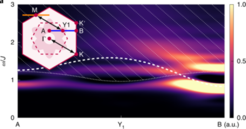Avoided quasiparticle decay from strong quantum interactions

Main panel: the out-of-plane dynamical spin structure factor along the blue line in the inset. The dotted line represents the two-magnon states consisting of a magnon along the orange line (inset) and a K-magnon. The dashed line is the magnon dispersion from LSWT. We see avoided decay, where the level-continuum repulsion induces a local minimum near Y1.
Quantum states of matter—such as solids, magnets and topological phases—typically exhibit collective excitations (for example, phonons, magnons and anyons). These involve the motion of many particles in the system, yet, remarkably, act like a single emergent entity—a quasiparticle. Known to be long lived at the lowest energies, quasiparticles are expected to become unstable when encountering the inevitable continuum of many-particle excited states at high energies, where decay is kinematically allowed. Although this is correct for weak interactions, we show that strong interactions generically stabilize quasiparticles by pushing them out of the continuum. This general mechanism is straightforwardly illustrated in an exactly solvable model.
Using state-of-the-art numerics, the scientists from the Max Planck Institute for the Physics of Complex Systems in Dresden find it at work in the spin-1/2 triangular-lattice Heisenberg antiferromagnet (TLHAF). This is surprising given the expectation of magnon decay in this paradigmatic frustrated magnet. Turning to existing experimental data, the detailed phenomenology of avoided decay in the TLHAF material Ba3CoSb2O9 was identified, and even in liquid helium, one of the earliest instances of quasiparticle decay. This work unifies various phenomena above the universal low-energy regime in a comprehensive description. This broadens our window of understanding of many-body excitations, and provides a new perspective for controlling and stabilizing quantum matter in the strongly interacting regime.
